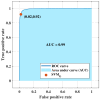Radiation-Free Microwave Technology for Breast Lesion Detection Using Supervised Machine Learning Model
- PMID: 36648997
- PMCID: PMC9844448
- DOI: 10.3390/tomography9010010
Radiation-Free Microwave Technology for Breast Lesion Detection Using Supervised Machine Learning Model
Abstract
Mammography is the gold standard technology for breast screening, which has been demonstrated through different randomized controlled trials to reduce breast cancer mortality. However, mammography has limitations and potential harms, such as the use of ionizing radiation. To overcome the ionizing radiation exposure issues, a novel device (i.e. MammoWave) based on low-power radio-frequency signals has been developed for breast lesion detection. The MammoWave is a microwave device and is under clinical validation phase in several hospitals across Europe. The device transmits non-invasive microwave signals through the breast and accumulates the backscattered (returned) signatures, commonly denoted as the S21 signals in engineering terminology. Backscattered (complex) S21 signals exploit the contrast in dielectric properties of breasts with and without lesions. The proposed research is aimed to automatically segregate these two types of signal responses by applying appropriate supervised machine learning (ML) algorithm for the data emerging from this research. The support vector machine with radial basis function has been employed here. The proposed algorithm has been trained and tested using microwave breast response data collected at one of the clinical validation centres. Statistical evaluation indicates that the proposed ML model can recognise the MammoWave breasts signal with no radiological finding (NF) and with radiological findings (WF), i.e., may be the presence of benign or malignant lesions. A sensitivity of 84.40% and a specificity of 95.50% have been achieved in NF/WF recognition using the proposed ML model.
Keywords: MammoWave’s dielectric breast response; X-ray free breast screening; non-invasive lesion detection; radiation-free technology; supervised machine learning.
Conflict of interest statement
Gianluigi Tiberi is shareholders of UBT—Umbria Bioengineering Technologies. This does not alter our adherence to MDPI journal policies on sharing data and materials.
Figures









References
-
- Miglioretti D.L., Lange J., Van Den Broek J.J., Lee C.I., Van Ravesteyn N.T., Ritley D., Kerlikowske K., Fenton J.J., Melnikow J., De Koning H.J., et al. Radiation-induced breast cancer incidence and mortality from digital mammography screening: A modeling study. Ann. Intern. Med. 2016;164:205–214. doi: 10.7326/M15-1241. - DOI - PMC - PubMed
-
- Seiffert K., Thoene K., Zu Eulenburg C., Behrens S., Schmalfeldt B., Becher H., Chang-Claude J., Witzel I. The effect of family history on screening procedures and prognosis in breast cancer patients-Results of a large population-based case-control study. Breast. 2021;55:98–104. doi: 10.1016/j.breast.2020.12.008. - DOI - PMC - PubMed
Publication types
MeSH terms
LinkOut - more resources
Full Text Sources
Medical

